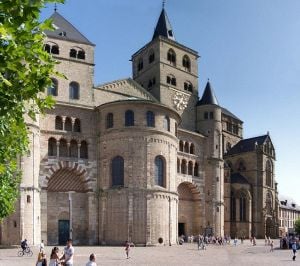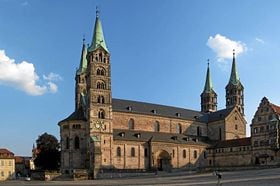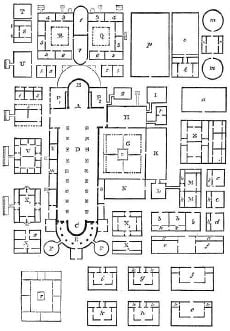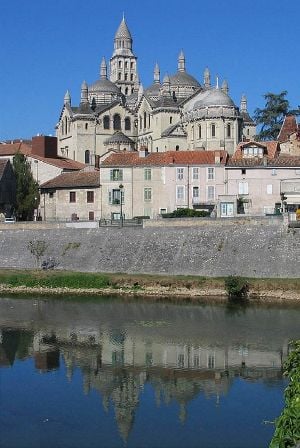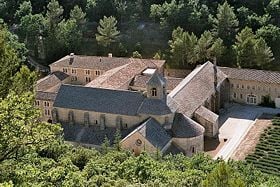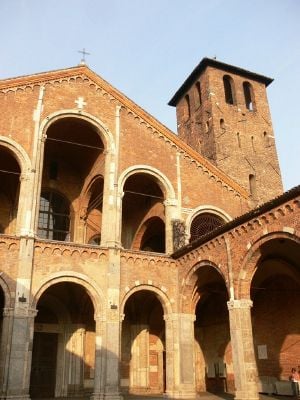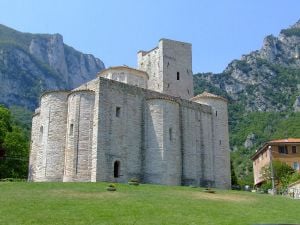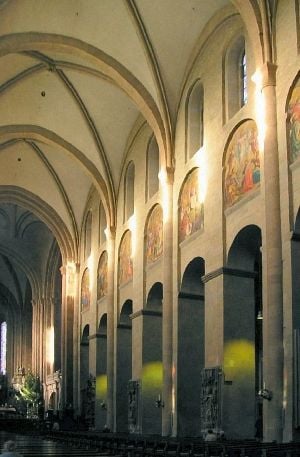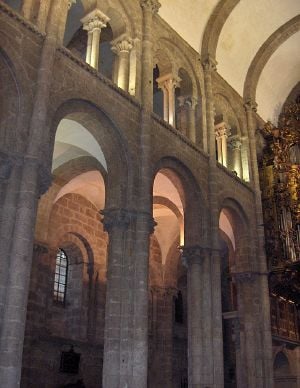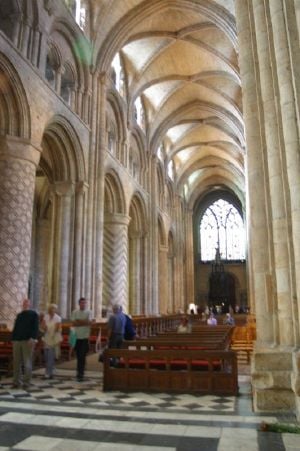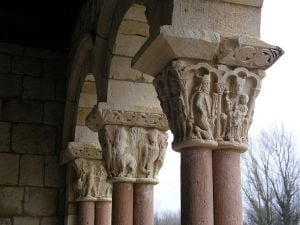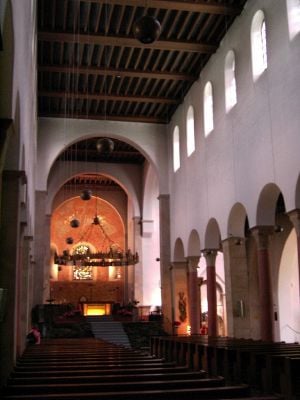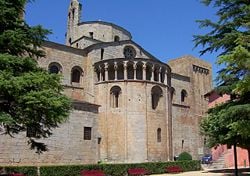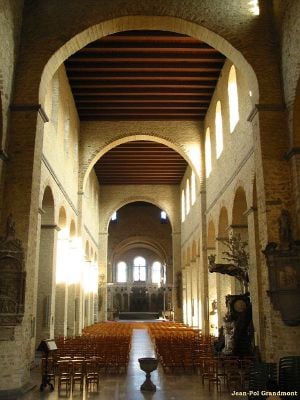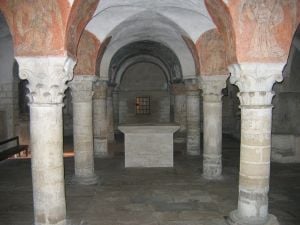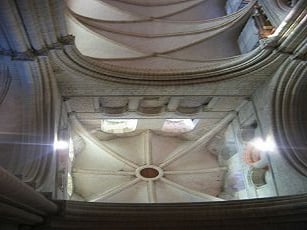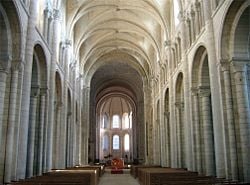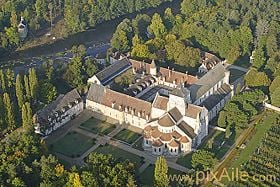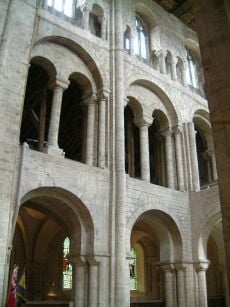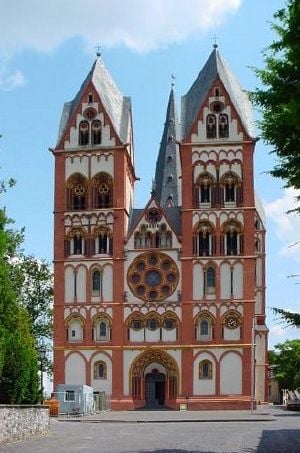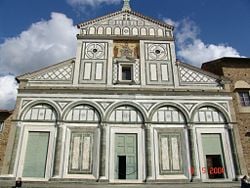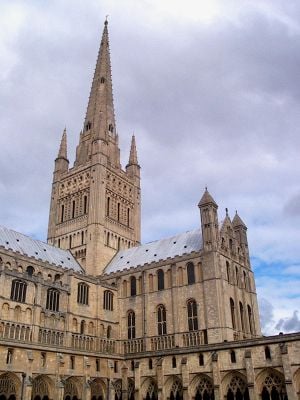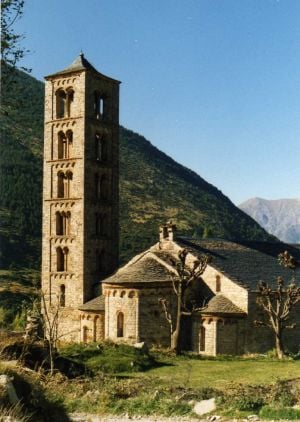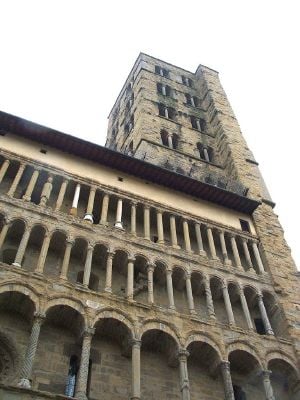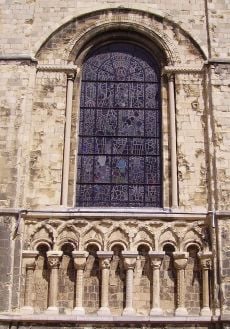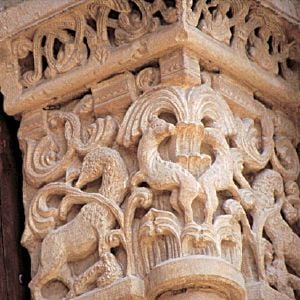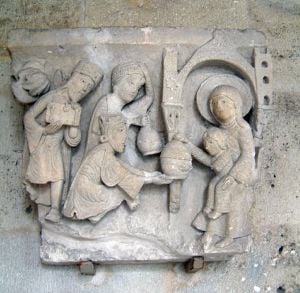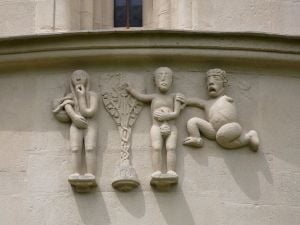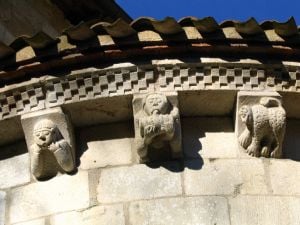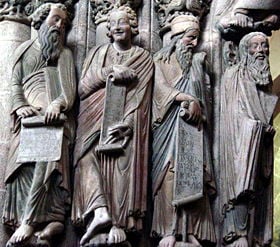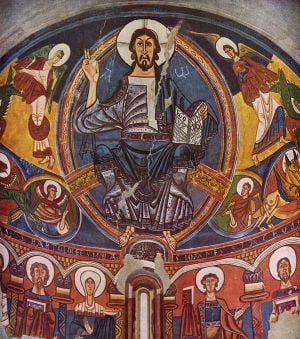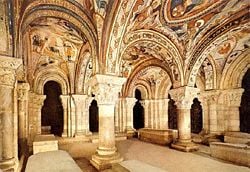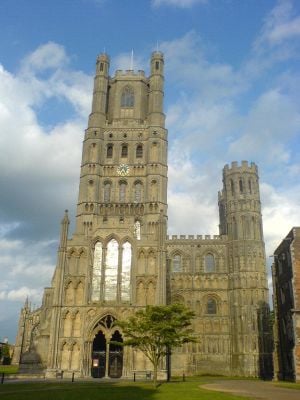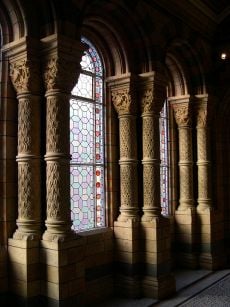Romanesque architecture
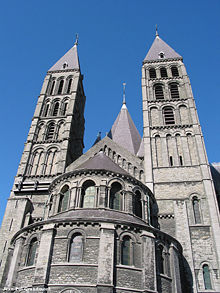
Romanesque architecture is the term that describes the architecture of Europe which emerged from the dark ages of the late tenth century and evolved into the Gothic style during the twelfth century. The Romanesque style in England is more traditionally referred to as Norman architecture.
Romanesque architecture is characterized by its massive quality, its thick walls, round arches, sturdy piers, groin vaults, large towers, and decorative arcading. Each building has clearly defined forms and frequently has very regular and symmetrical plans. The overall appearance is of simplicity when compared to the Gothic buildings that were to follow. The style can be identified across Europe, despite regional characteristics and a range of different materials.
Although there was a lot of building of castles during this period, they were greatly outnumbered by churches, (the most significant were the great abbey churches) many of which are still standing and frequently in use. [1]
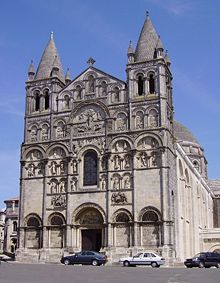
Definition
The term "Romanesque" was first applied by the archaeologist Charles de Gerville, in the early nineteenth century, to describe Western European architecture from the fifth to the thirteenth century, at a time when the actual dates of many of the buildings so described had not been ascertained.[2] The term is now used for a more restricted period from the late tenth to the twelfth century.
The word was used to describe the style which was identifiably Medieval and prefigured the Gothic, yet maintained the rounded Roman arch. The Romanesque style appeared to be a continuation of the Roman tradition of building, albeit a much simplified and less technically competent version.
The term "Pre-Romanesque art" is sometimes applied to architecture in Germany of the Carolingian and Ottonian periods. "First Romanesque" is applied to buildings in Italy, Spain, and parts of France that have Romanesque features but pre-date the influence of the monastery of Cluny.
History
Origins
Romanesque architecture was the first distinctive style to spread across Europe since the Roman Empire. Despite the nineteenth-century Art Historian's impression of Romanesque architecture as a continuation of Roman architecture, in fact, Roman building techniques in brick and stone were largely lost in most parts of Europe. In the more northern countries, the Roman style had never been adopted except for official buildings, while in Scandinavia Roman style was entirely unknown. There was little continuity, even in Rome where several of Constantine’s great basilicas continued to stand as an inspiration to later builders. It was not the buildings of ancient Rome, but the sixth century octagonal Byzantine basilica of San Vitale in Ravenna which was to inspire the greatest building of the Dark Ages in Western Europe, for example, the Emperor Charlemagne’s chapel at Aachen, built around the year 800 C.E. [3]
Dating shortly after Aachen Cathedral is a remarkable ninth century manuscript which shows the plan for the building of the monastery at St. Gall in Switzerland. It is a very detailed plan, with all the various monastic buildings and their functions labeled. The largest building is the church, the plan of which is distinctly Germanic, having an apse at both ends, an arrangement which is not generally seen elsewhere. Another feature of the church is its regular proportion, the square plan of the crossing tower providing a module for the rest of the plan. These features can both be seen at the Proto-Romanesque St. Michael's Church, Hildesheim, 1001-1030. [3]
Prior to the later influence of the Abbey of Cluny in the tenth century, architecture of a Romanesque style was simultaneously developing in northern Italy, parts of France, and in the Iberian Peninsula. The style, sometimes called "First Romanesque" or "Lombard Romanesque," is characterized by thick walls, lack of sculpture, and the presence of rhythmic ornamental arches known as a Lombard band.
Politics
The Holy Roman Empire had been established by Charlemagne, who was crowned by the Pope in St Peter's Basilica on Christmas Day in the year 800 C.E., with an aim to re-establish the old Pax Romanum, to the glory of Jesus Christ. Charlemagne’s political successors continued to rule much of Europe, with a gradual emergence of the separate political states which were eventually to become welded into nations, either by allegiance or defeat. In 1066, an invasion of England occurred by William, the Duke of Normandy. After the invasion, the England and Normandy unified and the building of both castles and churches reinforced the Norman presence.
Meanwhile, the east was at a time when the structures of the Roman Empire were falling into decay with its learning and technology lost. Many of the structures were being maintained in the Byzantine Empire where the building of masonry domes and the carving of decorative architectural details continued unabated and later styles greatly evolved after the fall of Rome. The domed churches of Constantinople and Eastern Europe were to greatly affect the architecture of certain towns, particularly through trade and through the Crusades. The most notable single building that demonstrates this is St Mark's Basilica Venice, but there are many lesser known examples, particularly in France, such as the church of Périgueux and the Angoulême Cathedral. [4]
Much of Europe was heavily influenced by feudalism, in which peasants held tenure from local rulers over the land that they farmed in exchange for military service. The result of this was that they could be called upon, not only for local and regional spats, but to follow their lord to travel across Europe to the Crusades, if they were required to do so. The Crusades, 1095-1270, brought about a very large movement of people in addition to ideas and trade skills, particularly those involved in the building of fortifications and the metal working needed for the provision of arms, which was also applied to the fitting and decoration of buildings. The continual movement of people, rulers, nobles, bishops, abbots, craftsmen, and peasants was an important factor in creating homogeneity in building methods and a recognizable Romanesque style, despite regional differences.
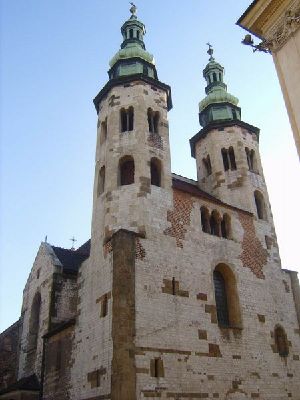
Religion
Across Europe, the late eleventh and twelfth centuries saw an unprecedented growth in the number of churches.[5] A great number of these buildings, both large and small, remain. They include many very well-known churches such as Santa Maria in Cosmedin in Rome[6], the Baptistery in Florence[7] and San Zeno Maggiore in Verona[8]. In France, the famous abbeys of Aux Dames and Les Hommes at Caen and Mont Saint-Michel date from this period, as well as the abbeys of the pilgrimage route to Santiago de Compostela. In England, of the twenty seven cathedrals of ancient foundation, all were begun in this period with the exception of Salisbury, where the monks relocated from Old Sarum, and several, such as Canterbury which were rebuilt on the site of Saxon churches.[9][10] In Spain, the most famous church of the period is Santiago de Compostela. In Germany, the Rhine and its tributaries were the location of many Romanesque abbeys, notably Mainz, Worms, Speyer, and Bamberg. In Cologne, formerly the largest city north of the Alps, a very important group of large city churches survives largely intact. As monasticism spread across Europe, Romanesque churches built up in Scotland, Scandinavia, Poland, Hungary, Sicily, Serbia, and Tunisia. Several important Romanesque churches were built in the Crusader kingdoms. [11][12]
Monasticism
The system of monasticism in which the mendicant become members of an order, with common ties and a common rule living in a mutually dependant community, was established by the monk Benedict in the sixth century. The Benedictine Monasteries spread from Italy throughout Europe, but were always by far the most numerous in England. They were followed by the Cluniac order, the Cistercians, Carthusians, and Augustinian Canons.
The monasteries, which sometimes also functioned as cathedrals, and the cathedrals which had bodies of secular clergy often living in community, were a major source of power in Europe. Bishops and the abbots of important monasteries lived and functioned like princes. The monasteries were the major seats of learning of all sorts. Benedict had ordered that all the arts were to be taught and practiced in the monasteries. The monasteries books were transcribed by hand and few people outside the monasteries could read or write. [1]
In France, Burgundy was the center of monasticism. The enormous and powerful monastery at Cluny was to have a lasting effect on the layout of other monasteries and the design of their churches. Unfortunately, very little of the abbey church at Cluny remains; the "Cluny II" rebuilding of 963 onwards has completely vanished, but we have a good idea of the design of "Cluny III" from 1088-1130, which until the Renaissance remained the largest building in Europe. However, the church of St. Sernin at Toulouse, 1080-1120, has remained intact and demonstrates the regularity of Romanesque design with its modular form, its massive appearance, and the repetition of the simple arched window motif. [3]
Pilgrimage and Crusade
One of the effects of the Crusades, which were intended to wrest the Holy Places of Palestine from Islamic control, was to excite a great deal religious fervor which in turn inspired great building programs. The Nobility of Europe, upon safe return, thanked God by the building of a new church or the enhancement of an old one. Likewise, those who did not return from the Crusades could be suitably commemorated by their family in a work of stone and mortar.
The Crusades resulted in the transfer of, among other things, a great number of Holy Relics of saints and apostles. Many churches, like Saint-Front, Périgueux, had their own home grown saint while others, most notably Santiago de Compostela, claimed the remains and the patronage of a powerful saint, in this case one of the Twelve Apostles. Santiago de Compostela, located near the western extremity of Galicia (present day Spain) became the most important pilgrimage destination in Europe. Most of the pilgrims travelled the Way of Saint James on foot, many of them barefooted as a sign of penance. They moved along one of the four main routes that passed through France, congregating for the journey at Jumieges, Paris, Vezelay, Cluny, Arles, and St. Gall in Switzerland. They crossed two passes in the Pyrenees and converged into a single stream to traverse north-western Spain. Along the route they were urged on by those pilgrims returning from the journey. On each of the routes abbeys such as those at Moissac, Toulouse, Roncesvalles, Conques, Limoges and Burgos catered for the flow of people and grew wealthy from the passing trade. Saint-Benoît-du-Sault, in the Berry province, is typical of the churches that were founded on the pilgrim route.[1][3]
Characteristics
The general impression given by Romanesque architecture, in both ecclesiastical and secular buildings, is one of massive solidity and strength. In contrast with both the preceding Roman and later Gothic architecture in which the load bearing structural members are, or appear to be, columns, pilasters, and arches. Romanesque architecture, in common with Byzantine architecture, relies upon its walls, or sections of walls called piers. [1]
Romanesque architecture is often divided into two periods known as the "First Romanesque" style and the "Romanesque" style. The difference is chiefly a matter of the expertise with which the buildings were constructed. The First Romanesque employed rubble walls, smaller windows and un-vaulted roofs. A greater refinement marks the Second Romanesque, along with increased use of the vault and dressed stone.
Walls
The walls of Romanesque buildings are often of massive thickness with few and comparatively small openings. They are often double shells, filled with rubble.
The building material differs greatly across Europe, depending upon the local stone and building traditions. In Italy, Poland, much of Germany, and Holland, brick is generally used. Other areas saw extensive use of limestone, granite, and flint. The building stone was often used in comparatively small and irregular pieces, bedded in thick mortar. Smooth ashlar masonry was not a distinguishing feature of the style, particularly in the earlier part of the period, but occurred chiefly where easily-worked limestone was available. [13]
Piers
In Romanesque architecture, piers were often employed to support arches. They were built of masonry and square or rectangular in section, generally having a horizontal molding representing a capital at the springing of the arch. Sometimes piers have vertical shafts attached to them, and may also have horizontal moldings at the level of base.
Although basically rectangular, piers can often be of highly complex form, with half-segments of large hollow-core columns on the inner surface supporting the arch, or a clustered group of smaller shafts leading into the moldings of the arch.
Piers that occur at the intersection of two large arches, such as those under the crossing of the nave and transept, are commonly cruciform in shape, each arch having its own supporting rectangular pier at right angles to the other. [1][3]
Columns
Salvaged columns
During this period in Italy, a great number of antique Roman columns were salvaged and reused in the interiors and on the porticos of churches. The most durable of these columns are of marble and have the stone horizontally bedded. The majorities are vertically bedded and are sometimes of a variety of colors. They may have retained their original Roman capitals, generally of the Corinthian or Roman Composite style. [11]
Some buildings, like the atrium at San Clemente in Rome, may have an odd assortment of columns in which large capitals are placed on short columns and small capitals are placed on taller columns to even the height. Architectural compromises of this type would have been unthinkable to either Roman or Gothic architects. Salvaged columns were also used to a lesser extent in France.
In Germany and other areas, small columns cut from a single piece of stone were used alternately between more massive piers.[11]
Drum columns
In most parts of Europe, Romanesque columns were massive, as they supported thick upper walls with small windows, and sometimes heavy vaults. The most common method of construction was to build them out of stone cylinders called drums, as in the crypt at Speyer Cathedral.[11][14]
Hollow core columns
Where really massive columns were called for, such as those at Durham Cathedral, columns had to be constructed of ashlar masonry, and the hollow core was filled with rubble. These huge un-tapered columns are sometimes ornamented with incised decorations. [10]
Capitals
The foliate Corinthian style provided the inspiration for many Romanesque capitals, and the accuracy with which they were carved depended very much on the availability of original models, those in Italian churches such as Pisa Cathedral and southern France being much closer to the Classical than those in England. [11][1]
The Corinthian capital is essentially round at the bottom where it sits on a circular column and square at the top, where it supports the wall or arch. This form of capital was maintained in the general proportions and outline of the Romanesque capital. This was achieved most simply by cutting a rectangular cube and taking the four lower corners off at an angle so that the block was square at the top, but octagonal at the bottom, as can be seen at St. Michael's Hildesheim.[11]
This shaped lent itself to a wide variety of superficial treatments, sometimes foliate in imitation of the source, but often figurative. In Northern Europe the foliate capitals generally bear far more resemblance to the intricacies of manuscript illumination than to Classical sources. In parts of France and Italy there are strong links to the pierced capitals of Byzantine architecture. It is in the figurative capitals that the greatest originality is shown. While some are dependent on manuscripts illustrations of Biblical scenes and depictions of beasts and monsters, others are lively scenes of the legends of local saints.[4]
The capitals, while retaining the form of a square top and a round bottom, were often compressed into little more than a bulging cushion-shape. This is particularly the case on large masonry columns, or on large columns that alternate with piers as at Durham.
Alternation
A common characteristic of Romanesque buildings, occurring both in churches and in the arcades which separate large interior spaces of castles, is the alternation of piers and columns.
The simplest form that this takes is to have a column between each adjoining pier. Sometimes the columns are in multiples of two or three. At St. Michael's, Hildesheim, an A-B-B-A alternation occurs in the nave while an A-B-A alternation can be seen in the transepts.
At Jumieges there are tall drum columns between piers each of which has a half-column supporting the arch. There are many variations on this theme, most notably at Durham Cathedral where the moldings and shafts of the piers are of exceptional richness and the huge masonry columns are each deeply incised with a different geometric pattern. [11]
Often the arrangement was made more complex by the complexity of the piers themselves, so that it was not piers and columns that alternated, but rather, piers of entirely different form from each other, such as those of Sant' Ambrogio, Milan where the nature of the vault dictated that the alternate piers bore a great deal more weight than the intermediate ones and are thus very much larger. [3]
Arches and openings
Arches in Romanesque architecture are semicircular, with the exception of a very small number of buildings such as Autun Cathedral in France and Monreale Cathedral in Sicily, both of which pointed arches have been used extensively. It is believed that in these cases there is a direct imitation of Islamic architecture.
While small windows might be surmounted by a solid stone lintel, larger windows are nearly always arched. Doorways are also surmounted by a semi-circular arch, except where the door is set into a large arched recess and surmounted by a semi-circular "lunette" with decorative carving. [3]
Vaults and roofs
The majority of buildings have wooden roofs, generally of a simple truss, tie beam, or king post form. In the case of trussed rafter roofs, they are sometimes lined with wooden ceilings in three sections like those which survive at Ely and Peterborough cathedrals in England. In churches, typically the aisles are vaulted, but the nave is roofed with timber, as is the case at both Peterborough and Ely.[10] In Italy, open wooden roofs are common, and tie beams frequently occur in conjunction with vaults, the timbers have often been decorated as at San Miniato al Monte, Florence.[1]
Vaults of stone or brick took on several different forms and showed marked development during the period, evolving into the pointed ribbed arch which is characteristic of Gothic architecture.
Barrel vault
The simplest type of vaulted roof is the barrel vault in which a single arched surface extends from wall to wall, the length of the space to be vaulted, for example, the nave of a church. An important example, which retains Medieval paintings, is the vault of Saint-Savin-sur-Gartempe, France, of the early twelfth century. However, the barrel vault generally required the support of solid walls, or walls in which the windows were very small. [11]
Groin vault
Groin vaults occur very frequently in earlier Romanesque buildings, and also for the less visible and smaller vaults in later buildings, particularly in crypts and aisles. A groin vault is almost always square in plan and is constructed of two barrel vaults intersecting at right angles. Unlike a ribbed vault, the entire arch is a structural member. Groin vaults are frequently separated by transverse arched ribs of low profile as at Santiago de Compostela. At La Madeleine, Vézelay, the ribs are square in section, strongly projecting and polychrome. [15]
Ribbed vault
In ribbed vaults, not only are there ribs spanning the vaulted area transversely, but each vaulted bay have diagonal ribs. In a ribbed vault, the ribs are the structural members, and the spaces between them can be filled with lighter, none-structural material.
Because Romanesque arches are nearly always semi-circular, the structural and design problem inherent in the ribbed vault is that the diagonal span is larger and therefore higher than the transverse span. The Romanesque builders used a number of solutions to this problem. One was to have the center point where the diagonal ribs met as the highest point, with the fill of all the surfaces sloping upwards towards it, in a domical manner. This solution was employed in Italy at San Michele, Pavia and Sant' Ambrogio, Milan.[11]
Another solution was to stilt the transverse ribs, or depress the diagonal ribs so that the centerline of the vault was horizontal, like that of a barrel vault. The latter solution was used on the sexpartite vaults at both the Saint-Etienne, the Abbaye-aux-Hommes, and Abbaye-aux-Dames at Caen, France, in the late eleventh and early twelfth centuries.[1]
Pointed arched vault
Late in the Romanesque period another solution came into use for regulating the height of diagonal and transverse ribs. This was to use arches of the same diameter for both horizontal and transverse ribs, causing the transverse ribs to meet at a point. This is seen most notably in northern England, at the Durham Cathedral dating from 1128. Durham is a cathedral of massive Romanesque proportions and appearance, yet its builders introduced several structural features which were new to architectural design and were to later to be hallmark features of the Gothic. Another Gothic structural feature employed at Durham is the flying buttress. However, these are hidden beneath the roofs of the aisles. The earliest pointed vault in France is that of the narthex of La Madeleine, Vézelay, dating from 1130.[13]
Church and cathedral plan and section
Many parish churches, abbey churches, and cathedrals are in the Romanesque style, or were originally built in the Romanesque style and have subsequently undergone changes. The simplest Romanesque churches are halls with a projecting apse at the chancel end, or sometimes, predominantly in England, a projecting rectangular chancel with a chancel arch that might be decorated with moldings. More ostentatious churches have aisles separated from the nave by arcades.
Abbey and cathedral churches generally follow the Latin Cross plan. In England, the extension eastward may be long, while in Italy it is often short or non-existent, as the church generally is built on a "T" plan, sometimes with apses on the transept ends as well as to the east. In France, the church of St Front, Perigueux, appears to have been modeled on St. Mark's Basilica, Venice or another Byzantine church and is of a Greek cross plan with five domes. In the same region, Angouleme Cathedral is an aisless church of the Latin cross plan, more usual in France, but is also roofed with domes. [11][1]
In Germany, Romanesque churches are often of distinctive form, having apses at east and west ends, the main entrance being central to one side. It is probable that this form came about to accommodate a baptistery at the west end. [13]
In section, the typical aisled church or cathedral has a nave with a single aisle on either side. The nave and aisles are separated by an arcade carried on piers or on columns. The roof of the aisle and the outer walls help to buttress the upper walls and vault of the nave, if present. Above the aisle roof are a row of windows know as the clerestory, which give light to the nave. During the Romanesque period there was a development from this two-stage elevation to a three-stage elevation in which there is a gallery, known as a triforium, between the arcade and the clerestory. This varies from a simple blind arcade decorating the walls, to a narrow arcaded passage, to a fully-developed second story with a row of windows lighting the gallery. [11]
Church and cathedral east ends
The eastern end of a Romanesque church is almost always semi-circular, with either a high chancel surrounded by an ambulatory as in France, or a square end form which an apse projects as in Germany and Italy. Where square ends exist in English churches, they are probably influenced by Anglo-Saxon churches. Peterborough and Norwich Cathedrals have retained round east ends in the French style. However, in France, simple churches without apses and with no decorative features were built by the Cistercians who also founded many houses in England, frequently in remote areas.[16]
Buttresses
Because of the massive nature of Romanesque walls, buttresses are not a highly significant feature, as they are in Gothic architecture. Romanesque buttresses are generally of flat square profile and do not project a great deal beyond the wall. In the case of aisled churches, barrel vaults, or half-barrel vaults over the aisles helped to buttress the nave, if it was vaulted.
In the cases where half-barrel vaults were used, they effectively became like flying buttresses. Often aisles extended through two stories, rather than the one usual in Gothic architecture, so as to better support the weight of a vaulted nave. In the case of Durham Cathedral, flying buttresses have been employed, but are hidden inside the triforium gallery.[10]
Church and cathedral facades and external decoration
Romanesque church facades, generally to the west end of the building, are usually symmetrical, have a large central portal made by its moldings or porch, and an arrangement of arched-topped windows. In Italy there is often a single central ocular window. The common decorative feature is arcading. [1]
Smaller churches often have a single tower which is usually placed to the western end, in France or England, either centrally or to one side, while larger churches and cathedrals often have two.
In France, Saint-Etienne, Caen presents the model of a large French Romanesque facade. It is a symmetrical arrangement of nave flanked by two tall towers each with two buttress of low flat profile which divide the facade into three vertical units. The three horizontal stages are marked by a large door set within an arch in each of the three vertical sections. The wider central section has two tiers of three identical windows, while in the outer tiers there are two tiers of single windows, that give emphasis to the mass of the towers. The towers rise through three tiers, the lowest of tall blind arcading, the next of arcading pierced by two narrow windows and the third of two large windows, divided into two lights by a colonette. [15]
This facade can be seen as the foundation for many other buildings, including both French and English Gothic churches. While the form is typical of northern France, its various components were common to many Romanesque churches of the period across Europe. Similar facades are found in Portugal. In England, Southwell Cathedral has maintained this form, despite the insertion of a huge Gothic window between the towers. Lincoln and Durham must once have looked like this. In Germany, Limbourg Cathedral has a rich variety of openings and arcades in horizontal stories of varying heights.
The churches of San Zeno Maggiore, Verona and San Michele, Pavia present two types of facades that are typical of Italian Romanesque, that reveal the architectural form of the building, and that which screens it. At San Zeno, the components of nave and aisles are made clear by the vertical shafts which rise to the level of the central gable and by the varying roof levels. At San Miniato al Monte the definition of the architectural parts is made even clearer by the polychrome marble, a feature of many Italian Medieval facades, particularly in Tuscany. At San Michele the vertical definition is present as at San Zeno, but the rooflines are screened behind a single large gable decorated with stepped arcading. At Santa Maria della Pieve, Arezzo this screening is carried even further, as the roofline is horizontal and the arcading rises in many different levels while the colonettes that support them have a great diversity of decoration. [13][3]
Towers
Towers were an important feature of Romanesque churches and a great number of them are still standing. They take a variety of forms, square, circular, and octagonal, and are positioned differently in relation to the church in different countries. In northern France, two large towers, such as those at Caen, were to become an integral part of the facade of any large abbey or cathedral. In central and southern France this is more variable and large churches may have one tower or a central tower. Large churches of Spain and Portugal usually have two towers.
Many abbeys of France, such as that at Cluny, had many towers of varied forms. This is also common in Germany, where the apses were sometimes framed with circular towers and the crossing surmounted by an octagonal tower as at Worms Cathedral. Large paired towers of square plan could also occur on the transept ends, such as those at Tournai Cathedral in Belgium. In Germany, where four towers frequently occur, they often have spires which may be four or eight sided, or the distinctive Rhenish helm shape seen on Limbourg Cathedral.[11]
In England, for large abbeys and cathedral buildings, three towers were favored, with the central tower being the tallest. This was often not achieved, through the slow process of the building stages, and in many cases the upper parts of the tower were not completed until centuries later as at Durham and Lincoln. Large Norman towers exist at the cathedrals of Durham, Exeter, Southwell, and Norwich. [10]
In Italy, towers are almost always free standing and the position is often dictated by the landform of the site, rather than aesthetics. This is the case in Italian nearly all churches both large and small, except in Sicily where a number of churches were founded by the Norman rulers and are more French in appearance. [1]
As a general rule, large Romanesque towers are square with corner buttresses of low profile, rising without diminishing through the various stages. Towers are usually marked into clearly defined stages by horizontal courses. As the towers rise, the number and size of openings increases as can be seen on the right tower of the transept of Tournai Cathedral where two narrow slits in the fourth level from the top becomes a single window, then two windows, then three windows at the uppermost level. This sort of arrangement is particularly noticeable on the towers of Italian churches, which are usually built of brick and may have no other ornament. Two fine examples occur at Lucca, at the church of Basilica di San Frediano and at the Lucca Cathedral. It is also seen in Spain. [1]
In Italy, there are a number of large free-standing towers which are circular, the most famous of these being the Leaning Tower of Pisa. In other countries where circular towers occur, such as Germany, they are usually paired and often flank an apse. Circular towers are uncommon in England, but occur throughout the Early Medieval period in Ireland.
Octagonal towers were often used on crossings and occur in France, Germany, Spain, and Italy where an example that is unusual for its height is that on the crossing of Sant' Antonio, Piacenza, 1140.
In Spain, in the twelfth century, a feature is the polygonal towers at the crossing. These have ribbed vaults and are elaborately decorated, such as the "Torre del Gallo" at Salamanca Old Cathedral. [11]
Decoration
Architectural embellishment
Arcading is the single most significant decorative feature of Romanesque architecture. It occurs in a variety of forms; from the Lombard band, a row of small arches that appear to support a roofline or course, to shallow blind arcading, a feature of English architecture and seen in great variety at Ely Cathedral, to open galleries, such as those on both Pisa Cathedral and its famous Leaning Tower. Arcades could be used to great effect, both externally and internally, as exemplified by the church of Santa Maria della Pieve, in Arezzo.[13]
Architectural sculpture
The Romanesque period produced a profusion of sculptural ornamentation. This most frequently took a purely geometric form and was particularly applied to moldings, both straight courses and the curved moldings of arches. In La Madeleine, Vezelay, for example, the polychrome ribs of the vault are all edged with narrow filets of pierced stone. Similar decoration occurs around the arches of the nave and along the horizontal course separating arcade and clerestory. Combined with the pierced carving of the capitals, this gives a delicacy and refinement to the interior. [13]
In England, such decoration could be discrete, as at Hereford and Peterborough cathedrals, or have a sense of massive energy as at Durham. In Durham, the diagonal ribs of the vaults are all outlined with chevrons, and the moldings of the nave arcade are carved with several layers in a variety of geometric patterns. These features combine to create one of the richest and most dynamic interiors of the Romanesque period.[17]
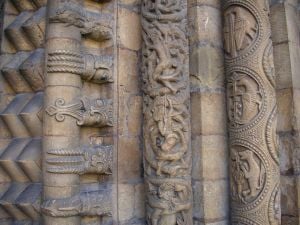
Although much sculptural ornament was sometimes applied to the interiors of churches, the focus of such decoration was generally the west front, and in particular, the portals. Chevrons and other geometric ornaments, referred to by nineteenth century writers as "barbaric ornament" are most frequently found on the moldings of the central door. Stylized foliage often appears as deeply carved and curling outward much like the acanthus leaves on Corinthian capitals, but also carved in shallow relief and spiral patterns, imitating the intricacies of manuscript illuminations. In general, the style of ornament was more classical in Italy, such as that seen around the door of Sant Giusto in Lucca, and more "barbaric" in England, Germany, and Scandinavia, such as that seen at Speyer Cathedral. France produced a great range of ornament, with particularly fine interwoven and spiraling vines in the "manuscript" style occurring at Saint-Sernin, Toulouse. [13][4][11]
Figurative sculpture
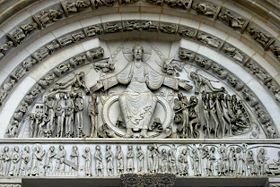
With the fall of the Roman Empire, the tradition of carving large works in stone and sculpting figures in bronze died out, as it effectively did (for religious reasons) in the Byzantine world. Some life-size sculptures were evidently done in stucco or plaster, but surviving examples are understandably rare. [18] The best-known surviving large sculptural work of Proto-Romanesque Europe is the life-size wooden Crucifix commissioned by Archbishop Gero of Cologne in about 965.[19] During the eleventh and twelfth centuries, figurative sculpture flourished. It was based on two other sources in particular, manuscript illumination and small-scale sculpture in ivory and metal. The extensive friezes sculpted on Armenian and Syriac churches are have been proposed as another likely influence.[20] These sources together produced a distinct style which can be recognized across Europe, although the most spectacular sculptural projects are concentrated in South-Western France, Northern Spain, and Italy.
Images that occurred in metalwork were frequently embossed. The resultant surface had two main planes and details that were usually incised. This treatment was adapted to stone carving and is seen particularly in the tympanum above the portal, where the imagery of Christ in Majesty with the symbols of the Four Evangelists is drawn directly from the gilt covers of medieval Gospel Books. This style of doorway occurs in many places and continued into the Gothic period. A rare survival in England is that of the "Prior's Door" at Ely Cathedral. In South-Western France, many have survived, with impressive examples at Saint-Pierre, Moissac, Souillac [21], and La Madaleine, Vézelay–all daughter houses of Cluny, with extensive other sculpture remaining in cloisters and other buildings. Nearby, Autun Cathedral has a Last Judgment of great rarity in that it has uniquely been signed by its creator, Giselbertus. [3][13]
A feature of the figures in manuscript illumination is that they often occupy confined spaces and are contorted to fit. The custom of artists to make the figure fit the available space lent itself to a facility in designing figures to ornament door posts, lintels, and other architectural surfaces. The robes of painted figures were commonly treated in a flat and decorative style that bore little resemblance to the weight and fall of actual cloth. This feature was also adapted for sculpture. Among the many examples that exist, one of the finest is the figure of the Prophet Jeremiah from the pillar of the portal of the Abbey of Saint-Pierre, Moissac, France, from about 1130. [13]
One of the most significant motifs of Romanesque design, occurring in both figurative and non-figurative sculpture is the spiral. One of the sources may be Ionic capitals. Scrolling vines were a common motif of both Byzantine and Roman design, and may be seen in mosaic on the vaults of the fourth century Church of Santa Costanza, Rome. Manuscripts and architectural carvings of the twelfth century have very similar scrolling vine motifs.
Another source of the spiral is clearly the illuminated manuscripts of the seventh to ninth centuries, particularly Irish manuscripts such as the St. Gall Gospel Book spread into Europe by the Hiberno-Scottish mission. In these illuminations, the use of the spiral has nothing to do with vines or other natural growth. The motif is abstract and mathematical. It is in an adaptation of this form that the spiral occurs in the draperies of both sculpture and stained glass windows. Of all the many examples that occur on Romanesque portals, one of the most outstanding is that of the central figure of Christ at La Madaleine, Vezelay. [13] Another influence from insular art are engaged and entwined animals, often used to superb effect in capitals (as at Silos) and sometimes on a column itself (as at Moissac).
Many of the smaller sculptural works, particularly capitals, are Biblical in subject and include scenes of Creation and the Fall of Man, episodes from the life of Christ and those Old Testament scenes which prefigure his Crucifixion of Christ and Resurrection, such as Jonah and the Whale and Daniel in the Lions' Den. Many nativity scenes occur; the theme of the Three Kings was particularly popular. The cloisters of Santo Domingo de Silos Abbey in Northern Spain and Moissac are fine examples surviving complete.
A feature of some Romanesque churches is the extensive sculptural scheme which covers the area surrounding the portal or, in some case, much of the facade. Angouleme Cathedral in France has a highly elaborate scheme of sculpture set within the broad niches created by the arcading of the facade. In Spain, an elaborate pictorial scheme in low relief surrounds the door of the church of Santa Maria at Ripoli. [13]
The purpose of the sculptural schemes was to convey a message that the Christian believer should recognize their wrong-doings, repent, and be redeemed. The Last Judgment reminds the believers to repent. The carved or painted Crucifix, displayed prominently within the church, reminded the sinner of their redemption. The sculpture which reminded the sinners of their sins often took alarming forms. Since they were not sculptures of Christ, they were usually not large and are rarely magnificent, but are often fearsome or simply entertaining in nature.
These are the works that frequently decorate the smaller architectural features. They are found on capitals, corbels, and bosses, or entwined in the foliage on door moldings. They represent the Seven Deadly Sins but often take forms that are not easily recognizable today. Lust, gluttony, and avarice are probably the most frequently represented. The appearance of many figures with oversized genitals can clearly be equated with carnal sin, but so also can the numerous figures shown with protruding tongues, which are a feature of the doorway of Lincoln Cathedral. Pulling ones beard was a symbol of masturbation, and pulling ones mouth wide open was also a sign of lewdity. A common theme found on capitals of this period is a tongue poker or beard stroker being beaten by his wife or seized by demons. Demons fighting over the soul of a wrongdoer such as a miser are another popular subject. [22]
Gothic architecture is usually considered to begin with the design of the choir at the Abbey of Saint-Denis, north of Paris, by the Abbot Suger, consecrated 1144. The beginning of Gothic sculpture is usually dated a little later, with the carving of the figures around the Royal Portal at Chartres Cathedral, France, 1150. The style of sculpture spread rapidly from Chartres, overtaking the new Gothic architecture. In fact, many churches of the late Romanesque period post-date the building at Saint-Denis. The sculptural style based more upon observation and naturalism than on formalized design developed rapidly. It is thought that one reason for the rapid development of naturalistic form was a growing awareness of Classical remains in places where they were most numerous and a deliberate imitation of their style. The consequence is that there are doorways which are Romanesque in form, and yet show naturalism associated with Early Gothic sculpture. [13]
One of these is the Pórtico da Gloria dating from 1180, at Santiago de Compostela. This portal is internal and is particularly well preserved, even retaining color on the figures and indicating the appearance of much architectural decoration which is now perceived as monochrome. Around the doorway are figures that are integrated with the colonnettes that make up the moldings of the doors. They are three dimensional, but slightly flattened. They are highly individualized, in appearance, expression, and bear a strong resemblance to those around the north porch of the Abbey of St. Denis, dating from 1170. Beneath the tympanum there is a carved row of figures playing a range of musical instruments.
Murals
The large wall surfaces and plain, curving vaults of the Romanesque period lent themselves to mural decoration. Unfortunately, many of these early wall paintings have been destroyed. In England, France, and the Netherlands such pictures were systematically destroyed in bouts of Reformation iconoclasm. In other countries they have suffered from war, neglect, and changing fashion.
A classic scheme for the full painted decoration of a church, derived from earlier examples often in mosaic, had, as its focal point in the semi-dome of the apse, Christ in Majesty or Christ the Redeemer by the four winged beasts, symbols of the Four Evangelists, comparing directly with examples from the gilt covers or the illuminations of Gospel Books of the period. If the Virgin Mary was the dedicatee of the church, her image might replace that of Christ. On the apse walls below would be saints and apostles, perhaps including narrative scenes, for example of the saint to whom the church was dedicated. On the sanctuary arch were figures of apostles, prophets or the twenty-four "Heavenly host," looking in towards a bust of Christ, or his symbol the Lamb, at the top of the arch. The north wall of the nave would contain narrative scenes from the Old Testament, and the south wall from the New Testament. On the rear west wall would be a Last Judgment, with an enthroned and judging Christ at the top.[23]
One of the most intact schemes to exist is that at Saint-Savin-sur-Gartempe in France. The long barrel vault of the nave provides an excellent surface for frescoes, and is decorated with scenes of the Old Testament, showing the Creation, the Fall of Man and other stories. Similar paintings exist in Serbia, Spain, Germany, Italy, and elsewhere in France. [11]
Stained glass
The oldest-known fragments of medieval pictorial stained glass appear to date from the tenth century. The earliest intact figures are five prophet windows at Augsburg, dating from the late eleventh century. The figures, though stiff and formalized, demonstrate considerable proficiency in design, both pictorially and in the functional use of the glass, indicating that their maker was well accustomed to the medium. At Canterbury and Chartres Cathedrals, a number of panels of the twelfth century have survived, including, at Canterbury, a figure of Adam digging, and another of his son Seth from a series of Ancestors of Christ. Adam represents a highly naturalistic and lively portrayal, while in the figure of Seth, the robes have been used to great decorative effect, similar to the best stone carving of the period.
Most of the magnificent stained glass of France, including the famous windows of Chartres, dates from the thirteenth century. Far fewer large windows remain intact from the twelfth century. One such is the Crucifixion of Poitiers, a remarkable composition which rises through three stages, the lowest with a quatrefoil depicting the Martyrdom of St Peter, the largest central stage dominated by the crucifixion and the upper stage showing the Ascension of Christ in a mandorla. The figure of the crucified Christ is already showing the Gothic curve. The window is described by George Seddon as being of "unforgettable beauty".[24]
Transitional style
During the twelfth century, features that were to become typical of Gothic architecture began to appear. It is not uncommon, for example, for a part of building that has been constructed over a lengthy period extending into the twelfth century, to have very similar arcading of both semi-circular and pointed shape, or windows that are identical in height and width, but in which the later ones are pointed. This can be seen on the towers of Tournai Cathedral and on the western towers and facade at Ely Cathedral. Other variations that appear to hover between Romanesque and Gothic occur, such as the facade designed by Abbot Suger at the Abbey of Saint-Denis which retains much that is Romanesque in its appearance, and the Facade of Laon Cathedral which, despite its Gothic form, has round arches. [10][25]
Romanesque influence
Paris and its surrounding area were quick to adopt the Gothic style of Abbot Suger, Abbey of Saint-Denis in the twelfth century but other parts of France were slower to take it up, and provincial churches continued to be built in the heavy rubble stone of the Romanesque, even when the openings were treated with the fashionable pointed arch.
In England, the Romanesque ground plan commonly had a very long nave that continued to affect the style of building of cathedrals and those large abbey churches which were also to become cathedrals in the sixteenth century. Despite the fact that English cathedrals were rebuilt in many stages, substantial areas of Norman building can be seen in many of them, particularly in the nave arcades. In the case of Winchester Cathedral, the Gothic arches were literally carved out of the existent Norman piers. [10]
In Italy, although many churches such as Florence Cathedral and Santa Maria Novella were built in the Gothic style, sturdy columns with capitals of a modified Corinthian form continued to be used. The pointed vault was utilized where convenient, but it is commonly interspersed with semicircular arches and vaults wherever they conveniently fit. The facades of Gothic churches in Italy are not always easily distinguishable from the Romanesque.
Germany was not quick to adopt the Gothic style, and when it did so, often the buildings were modeled very directly upon French cathedrals, as Cologne Cathedral was modeled on Amiens. The smaller churches and abbeys continued to be constructed in a more provincial Romanesque manner, the date only being registered by the pointed window openings. [13]
A Monumental Style: Romanesque Architecture at its Best
Durham Cathedral
While the term Romanesque, to many, is nothing more than a transition leading up to the Gothic, it is easily forgotten that this style illuminated Europe as it came from the depths of the Dark Ages. There are a myriad of cathedrals and churches that capture the spirit of Romanesque architecture. One of the most prominent, Durham Cathedral, was built in the early tenth century, during the beginning of the Romanesque style. The cathedral towered high on a hilltop, hovering above the landscape like a castle watching over its terrain. "Its interior is cavernous and spectacularly so: the pointed, almost Gothic, ribs that hold up the vaults are in turn supported by rows of massive columns, alternately round and compound (composed of several smaller columns). The surfaces of the round columns are deeply incised by ax carvings–zig-zags and diamond patterns predominate...cutter." [26] In fact, much of the architectural decorations of the period were carved into the structural fabric. The extreme masculinity of the work is undeniable, and is one of the prime characteristics of Romanesque art and architecture.
Major Works of Romanesque Art
- Durham Cathedral
- Speyer Cathedral
- Sant'Ambrogio, Milan
- Monreale Cathedral
- Abbey Church of S. Miniatro al Monte, Florence
- Baptistry, Florence
- Notre-Dame-la-Grande, Poitiers, France.
- Abbey Church of St.Pierre, Moissac, France
- Abbey Church of St. Philibert
- Tournai Cathedral
- Leaning Tower of Pisa
Romanesque Revival
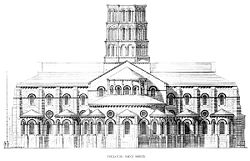
During the nineteenth century, when Gothic Revival architecture was fashionable, buildings were occasionally designed in the Romanesque style. There are a number of Romanesque Revival churches, dating from as early as the 1830s and continuing into the twentieth century where the massive and "brutal" quality of the Romanesque style was appreciated and designed in brick.
The Natural History Museum, London designed by Alfred Waterhouse, 1879, on the other hand, is a Romanesque revival building which makes full use of the decorative potential of Romanesque arcading and architectural sculpture. The Romanesque appearance has been achieved while freely adapting an overall style to suit the function of the building. The columns of the foyer, for example, give an impression of incised geometric design similar to those of Durham Cathedral. However, the sources of the incised patterns are the trunks of palms, cycads and tropical tree ferns. The animal motifs, of which there are many, include rare and exotic species.
The type of modern buildings for which the Romanesque style was most frequently adapted was the warehouse, where a lack of large windows and an appearance of great strength and stability were desirable features. These buildings, generally of brick, frequently have flattened buttresses rising to wide arches at the upper levels after the manner of some Italian Romanesque facades. This style was adapted to suit commercial buildings by opening the spaces between the arches into large windows, the brick walls becoming a shell to a building that was essentially of modern steel-frame construction, the architect Henry Hobson Richardson giving his name to the style, "Richardson Romanesque." Good examples of the style are Marshall Fields store, Chicago by H.H.Richardson, 1885, and the Chadwick Lead Works in Boston by William Preston, 1887. The style also lent itself to the building of cloth mills, steelworks, and power stations. [15][1]
Notes
- ↑ 1.00 1.01 1.02 1.03 1.04 1.05 1.06 1.07 1.08 1.09 1.10 1.11 1.12 Bannister Fletcher, A History of Architecture on the Comparative Method’’.
- ↑ Jean Hubert, Romanesque Art.
- ↑ 3.0 3.1 3.2 3.3 3.4 3.5 3.6 3.7 3.8 Gardner, Helen. Art through the Ages’’.
- ↑ 4.0 4.1 4.2 George Holmes, ed. The Oxford History of Medieval Europe.
- ↑ "In the years that followed the year 1000, we witnessed the rebuilding of churches all over the universe, but especially in Italy and Gaul." Chronicle of Raoul Glaber, quoted by Jean Hubert, Romanesque Art.
- ↑ famous for the ancient Roman "Mouth of Truth" set into the wall of its narthex
- ↑ famous for the 15th century Ghiberti Doors
- ↑ traditionally the marriage place of Romeo and Juliet
- ↑ John Harvey, English Cathedrals
- ↑ 10.0 10.1 10.2 10.3 10.4 10.5 10.6 Alec Clifton-Taylor, The Cathedrals of England
- ↑ 11.00 11.01 11.02 11.03 11.04 11.05 11.06 11.07 11.08 11.09 11.10 11.11 11.12 11.13 11.14 Rolf Toman, Romanesque.
- ↑ National Tourism Organization of Serbia[1]
- ↑ 13.00 13.01 13.02 13.03 13.04 13.05 13.06 13.07 13.08 13.09 13.10 13.11 13.12 Rene Hyughe, Larousse Encyclopedia of Byzantine and Medieval Art
- ↑ This technique was also used in the Classical world, notably at the Parthenon.
- ↑ 15.0 15.1 15.2 Nikolaus Pevsner, An Ouline of European Architecture
- ↑ F.H.Crossley, The English Abbey.
- ↑ Alec Clifton-Taylor says, "With the Cathedral of Durham we reach the incomparable masterpiece of Romanesque architecture not only in England but anywhere."
- ↑ Some ninth century near life-size stucco figures were discovered behind a wall in Santa Maria in Valle, Cividale del Friuli in Northern Italy relatively recently. Atroshenko and Collins p. 142
- ↑ See details at Cologne Cathedral.
- ↑ Atroshenko, V.I. and Judith Collins, The Origins of the Romanesque,p. 144-50, Lund Humphries: London, 1985. ISBN 085331487X
- ↑ slides from Boston College
- ↑ Website, Satan in the Groin [2]
- ↑ Hall, James. A History of Ideas and Images in Italian Art, p154, John Murray: London, 1983. ISBN 0719539714
- ↑ George Seddon in Lee, Seddon and Stephens, Stained Glass
- ↑ Wim Swaan, Gothic Cathedrals
- ↑ Glancey, Jonathan. The Story of Architecture
ReferencesISBN links support NWE through referral fees
- Rolf, Toman. Romanesque. Könemann. 1997. ISBN 3895084476
- Fletcher, Banister. A History of Architecture on the Comparative method. Elsevier Science & Technology, 2001. ISBN 0750622679
- Gardner, Helen, Fred S. Kleiner, Christin J. Mamiya. Gardner's Art through the Ages. Thomson Wadsworth, 2004. ISBN 0155050907
- Holmes, George.,editor. The Oxford Illustrated History of Medieval Europe. Oxford University Press, 1992. ISBN 0198200730
- Huyghe, René. Larousse Encyclopedia of Byzantine and Medieval Art. Bookthrift Co., 1981. ISBN 9780896730809
- Ischer, Francois. Building the Great Cathedrals. Harry N. Abrams, 1998. ISBN 0810940175
- Pevsner, Nikolaus. An Outline of European Architecture. Pelican Books, 1991. ISBN 9780140135244
- Beckwith, John. Early Medieval Art. Thames and Hudson, 1985. ISBN 9780500200193
- Kidson, Peter. The Medieval World. Paul Hamly, 1967.
- Bumpus, T. Francis. The Cathedrals and Churches of Belgium. T. Werner Laurie, 1928.
- Clifton-Taylor, Alec. The Cathedrals of England. Thames and Hudson, 1989. ISBN 9780500200629
- Harvey, John. English Cathedrals. Batsford, 1961.
See also
- Romanesque art
- Romanesque sculpture
- Romanesque Revival architecture
- Medieval architecture
- Pre-Romanesque art
- Ottonian architecture
- Gothic architecture
External links
All links retrieved December 15, 2022.
- Corpus of Romanesque Sculpture in Britain and Ireland
- Vigeois Illustrated history (French)
- French Romanesque art through 150 places {fr}{es}{en}
- Spanish Romanesque art {es}
- Satan in the Groin - exhibitionist carvings on mediæval churches
| Architectural history | Architectural timeline |
| Neolithic • Ancient Egyptian • Mayan • Sumerian • Classical • Mesoamerican • Ancient Greek • Roman • Incan • Sassanid • Byzantine • Islamic • Newari • Buddhist • Medieval • Persian • Romanesque • Gothic • Hoysala • Vijayanagara • Renaissance • Ottoman • Baroque • Neoclassical • Neo-Renaissance • Gothic Revival • Modern • Postmodern |
| Related articles |
Credits
New World Encyclopedia writers and editors rewrote and completed the Wikipedia article in accordance with New World Encyclopedia standards. This article abides by terms of the Creative Commons CC-by-sa 3.0 License (CC-by-sa), which may be used and disseminated with proper attribution. Credit is due under the terms of this license that can reference both the New World Encyclopedia contributors and the selfless volunteer contributors of the Wikimedia Foundation. To cite this article click here for a list of acceptable citing formats.The history of earlier contributions by wikipedians is accessible to researchers here:
The history of this article since it was imported to New World Encyclopedia:
Note: Some restrictions may apply to use of individual images which are separately licensed.
